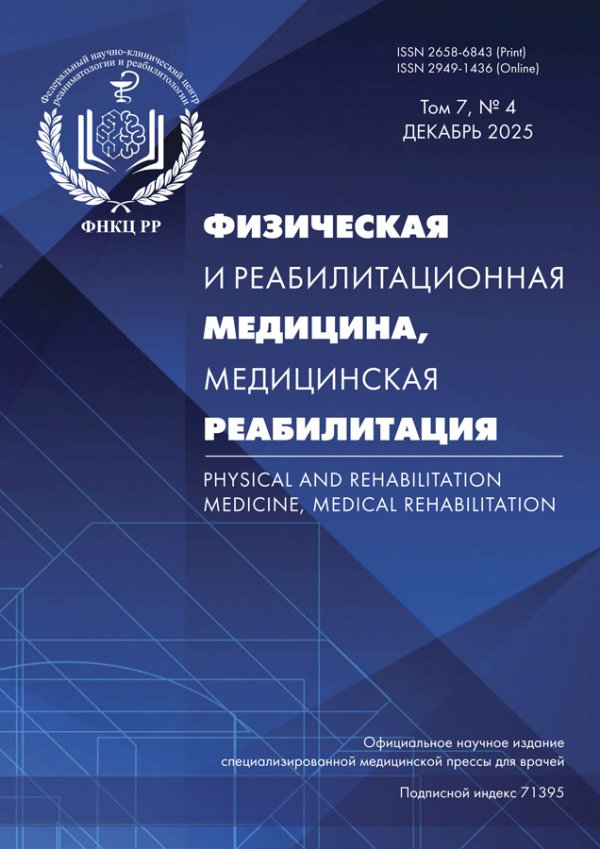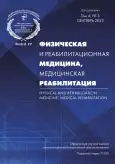Possibilities of endoscopic evaluation of swallowing function in patients with chronic disorders of consciousness
- Authors: Kondratyeva E.A.1,2,3, Lesteva N.A.1, Verbitskaya E.V.4, Kondratyev S.A.1, Petrova A.B.1, Ivanova N.E.1, Kondratyev A.N.1
-
Affiliations:
- Almazov National Medical Research Centre
- Kirov Military medical academy
- Federal Research and Clinical Center of Intensive Care Medicine and Rehabilitology
- Academician I.P. Pavlov First St. Petersburg State Medical University
- Issue: Vol 4, No 3 (2022)
- Pages: 140-153
- Section: ORIGINAL STUDY ARTICLE
- URL: https://journals.rcsi.science/2658-6843/article/view/110856
- DOI: https://doi.org/10.36425/rehab110856
- ID: 110856
Cite item
Full Text
Abstract
BACKGROUND: The period of coma in some patients after severe brain damage ends with a transition to one of the forms of chronic disorders of consciousness ― a vegetative state/unresponsive wakefulness syndrome or a minimally conscious state. Almost all patients with chronic disorders of consciousness have dysphagia of varying severity, and therefore nutrition of this category of patients is carried out initially through a nasogastric tube, and then through a gastrostomy. Early tracheostomy cannula removal may lead to the development of aspiration and pneumonia. Dysphagia is often not diagnosed in chronic disorders of consciousness patients.
AIMS: Analysis of the results of fibrooptic endoscopic assessment of swallowing in chronic disorders of consciousness patients to identify the relationship between the presence and severity of dysphagia with the level of consciousness, data on the coma recovery scale, as well as the duration of consciousness disorders and dynamics of recovery of consciousness.
MATERIALS AND METHODS: The study was of a prospective type, conducted in the period from 2019 to 2021. 39 chronic disorders of consciousness patients (18 ― vegetative state/unresponsive wakefulness syndrome, 18 ― minimally conscious state "minus" and minimally conscious state "plus" and 3 patients with a level of consciousness corresponding to the emergence from the minimally conscious state). The average duration of chronic disorders of consciousness was 7.7±9.4 months. All patients underwent a neurological examination using the CRS-R upon admission to the hospital and a month later, an endoscopic examination of the swallowing function was performed with scores calculated according to the Federal Endoscopic Dysphagia Severity Assessment Scale (FEDSS) and aspiration assessment scale in accordance with the Rosenbek criteria.
RESULTS: Dysphagia of varying severity was detected in 36 patients (92.3%). The correlation of the total CRS-R score with the degree of dysphagia (Ro=-0.481, p=0.002) was found. The degree of dysphagia did not depend on the chronic disorders of consciousness duration.
CONCLUSION: Regardless of the chronic disorders of consciousness severity (vegetative state/unresponsive wakefulness syndrome, minimally conscious state "minus", minimally conscious state "plus") before tracheostomy removing and switching to the oral feeding, it is necessary to perform fibrooptic endoscopic studies of swallowing to detect dysphagia, determine its degree, which is a method of preventing complications of the decanulation consequences.
Full Text
##article.viewOnOriginalSite##About the authors
Ekaterina A. Kondratyeva
Almazov National Medical Research Centre; Kirov Military medical academy; Federal Research and Clinical Center of Intensive Care Medicine and Rehabilitology
Author for correspondence.
Email: eak2003@mail.ru
ORCID iD: 0000-0001-6362-6543
SPIN-code: 6966-3270
MD, Dr. Sci. (Med.)
Russian Federation, Saint Petersburg; Saint Petersburg; MoscowNataliya A. Lesteva
Almazov National Medical Research Centre
Email: lestevan@mail.ru
ORCID iD: 0000-0002-9341-7440
SPIN-code: 3450-2917
MD, Cand. Sci. (Med.)
Russian Federation, Saint PetersburgElena V. Verbitskaya
Academician I.P. Pavlov First St. Petersburg State Medical University
Email: Elena.verbitskaya@gmail.com
ORCID iD: 0000-0003-3770-993X
SPIN-code: 4701-8118
Cand. Sci. (Biol.), Associate Professor
Russian Federation, Saint PetersburgSergey A. Kondratyev
Almazov National Medical Research Centre
Email: 3773717@mail.ru
ORCID iD: 0000-0001-5028-5938
SPIN-code: 1690-7350
MD, Cand. Sci. (Med.)
Russian Federation, Saint PetersburgAlina B. Petrova
Almazov National Medical Research Centre
Email: petrova_ab17@mail.ru
ORCID iD: 0000-0003-1622-1142
SPIN-code: 3726-8393
Russian Federation, Saint Petersburg
Natalya E. Ivanova
Almazov National Medical Research Centre
Email: Ivamel@yandex.ru
ORCID iD: 0000-0003-2790-0191
SPIN-code: 1854-7827
MD, Dr. Sci. (Med.), Professor
Russian Federation, Saint PetersburgAnatolii N. Kondratyev
Almazov National Medical Research Centre
Email: anest-neuro@mail.ru
ORCID iD: 0000-0002-7648-2208
SPIN-code: 8235-9765
MD, Dr. Sci. (Med.), Professor
Russian Federation, Saint PetersburgReferences
- Piradov MA, Suponeva NA, Voznyuk IA, et al. Chronic disorders of consciousness: terminology and diagnostic criteria. The results of the first meeting of the Russian Working Group for Chronic Disorders of Consciousness. Ann Clin Experimental Neurology. 2020;14(1):5−16. (In Russ). doi: 10.25692/ACEN.2020.1.1
- Belkin AA, Suponeva NA, Voznyuk IA, et al. Prolonged disorder of consciousness — a new concept in the evaluation of chronical disorders of consciousness in ICU patients. A multi-disciplinary concensus. Bulletin Intensive Therapy Named After A.I. Saltanov. 2021;(2):7–16. (In Russ). doi: 10.21320/1818-474X-2021-2-7-16
- Bruno MA, Laureys S, Demertzi A. Coma and disorders of consciousness. Handb Clin Neurol. 2013;118:205–213. doi: 10.1016/B978-0-444-53501-6.00017-2
- Giacino JT, Katz DI, Schiff ND, et al. Comprehensive systematic review update summary: Disorders of consciousness: Report of the Guideline Development, Dissemination, and Implementation Subcommittee of the American Academy of Neurology; the American Congress of Rehabilitation Medicine; and the National Institute on Disability, Independent Living, and Rehabilitation Research. Neurology. 2018;91(10):461−470. doi: 10.1212/WNL.0000000000005928
- Kondziella D, Bender A, Diserens K, et al. EAN Panel on Coma, Disorders of Consciousness. European Academy of Neurology guideline on the diagnosis of coma and other disorders of consciousness. Eur J Neurol. 2020;27(5):741−756. doi: 10.1111/ene.14151
- Mélotte E, Maudoux A, Delhalle S, et al. Swallowing in individuals with disorders of consciousness: a cohort study. Ann Phys Rehabil Med. 2021;64(4):101403. doi: 10.1016/j.rehab.2020.04.008
- Goryachev AS, Savin IA, Pucillo MV, et al. Evaluation scale and therapeutic strategies for swallowing disorders in patients with brain stem injuries. Issues Neurosurgery. 2006(4):24−28. (In Russ).
- Belkin AA, Alasheev AM, Belkin VA, et al. Rehabilitation in the intensive care unit (intensive care unit). Methodological recommendations of the Union of Rehabilitologist of Russia and the Federation of Anesthesiologists and Resuscitators. Bulletin Intensive Therapy Named After A.I. Saltanov. 2022;(2):7–40. (In Russ). doi: 10.21320/1818-474X-2022-2-7-40
- Belkin AA. Syndrome of consequences of intensive therapy (PIT syndrome). Bulletin Intensive Therapy Named After A.I. Saltanov. 2018;(2):12–23. (In Russ). doi: 10.21320/1818-474X-2018-2-12-23
- Belkin AA, Davydova NS, Leiderman IN, et al. Clinical recommendations. Anesthesiology and resuscitation. Rehabilitation in intensive care. Moscow: GEOTAR-Media; 2016. Р. 833−858. (In Russ).
- Pistoia F, Sacco S, Franceschini M, et al. Comorbidities: a key issue in patients with disorders of consciousness. J Neurotrauma. 2015;32(10):682−688. doi: 10.1089/neu.2014.3659
- Ganesh S, Guernon A, Chalcraft L, et al. Medical comorbidities in disorders of consciousness patients and their association with functional outcomes. Arch Phys Med Rehabil. 2013;94(10):1899−907. doi: 10.1016/j.apmr.2012.12.026
- Godbolt AK, Stenberg M, Jakobsson J, et al. Subacute complications during recovery from severe traumatic brain injury: frequency and associations with outcome. BMJ Open. 2015;5(4):e007208. doi: 10.1136/bmjopen-2014-007208
- Galeoto G, Turriziani S, Berardi A, et al. Levels of cognitive functioning assessment scale: Italian cross-cultural adaptation and validation. Ann Ig. 2020;32(1):16−26. doi: 10.7416/ai.2020.2326
- Raciti L, Raciti G, Pulejo G, et al. Neurogenic dysphagia and nutrition in disorder of consciousness: an overview with practical advices on an “old” but still actual clinical problem. Medicines (Basel). 2022;9(2):16. doi: 10.3390/medicines9020016
- Yan N, Jiang J, Liu H, et al. Evidence-based bundled care for patients with dysphagia after severe traumatic brain injury: a randomized controlled trial. Am J Transl Res. 2021;13(7):7819−7828.
- Sebastian S, Nair PG, Thomas P, Tyagi AK. Oropharyngeal dysphagia: neurogenic etiology and manifestation. Indian J Otolaryngol Head Neck Surg. 2015;67(Suppl 1):119−123. doi: 10.1007/s12070-014-0794-3
- Moore JD, Kleinfeld D, Wang F. How the brainstem controls orofacial behaviors comprised of rhythmic actions. Trends Neurosci. 2014;37(7):370−380. doi: 10.1016/j.tins.2014.05.001
- Langmore SE, Schatz K, Olsen N. Fiberoptic endoscopic examination of swallowing safety: a new procedure. Dysphagia. 1988;2(4):216−219. doi: 10.1007/BF02414429
- Bremare A, Rapin A, Veber B, et al. Swallowing disorders in severe brain injury in the arousal phase. Dysphagia. 2016;31(4):511−520. doi: 10.1007/s00455-016-9707-9
- Checklin M, Dahl T, Tomolo G. Feasibility and safety of fiberoptic endoscopic evaluation of swallowing in people with disorder of consciousness: a systematic review. Dysphagia. 2022;37(4):778−787. doi: 10.1007/s00455-021-10327-y
- Amosova NN, Balashova IN, Belkin AA, et al. Diagnosis and treatment of dysphagia in diseases of the central nervous system. Clinical recommendations. Bulletin Restorative Med. 2014;(4):99−115. (In Russ).
- Hamdy S, Mikulis DJ, Crawley A, et al. Cortical activation during human volitional swallowing: an event-related fMRI study. Am J Physiol. 1999;277(1):219−225. doi: 10.1152/ajpgi.1999.277.1.G219
- Kern MK, Jaradeh S, Arndorfer RC, Shaker R. Cerebral cortical representation of reflexive and volitional swallowing in humans. Am J Physiol Gastrointest Liver Physiol. 2001;280(3): 354−360. doi: 10.1152/ajpgi.2001.280.3.G354
- Martin RE, Goodyear BG, Gati JS, Menon RS. Cerebral cortical representation of automatic and volitional swallowing in humans. J Neurophysiol. 2001;85(2):938−950. doi: 10.1152/jn.2001.85.2.938
- Hamdy S, Mikulis DJ, Crawley A, et al. Cortical activation during human volitional swallowing: an event-related fMRI study. Am J Physiol. 1999;277(1):219−225. doi: 10.1152/ajpgi.1999.277.1.G219
- Dellow PG, Lund JP. Evidence for central timing of rhythmical mastication. J Physiol. 1971;215(1):1−13. doi: 10.1113/jphysiol.1971.sp009454
- Mélotte E, Maudoux A, Panda R, et al. Links between swallowing and consciousness: a narrative review. Dysphagia. 2022. doi: 10.1007/s00455-022-10452-2
- Wang J, Wang J, Hu X, et al. The initiation of swallowing can indicate the prognosis of disorders of consciousness: a self-controlled study. Front Neurol. 2019;10:1184. doi: 10.3389/fneur.2019.01184
- Mélotte E, Maudoux A, Delhalle S, et al. Is oral feeding compatible with an unresponsive wakefulness syndrome? J Neurol. 2018;265(4):954−961. doi: 10.1007/s00415-018-8794-y
- Mélotte E, Belorgeot M, Herr R, et al. The development and validation of the SWADOC: a study protocol for a multicenter prospective cohort study. Front Neurol. 2021;12:662634. doi: 10.3389/fneur.2021.662634
Supplementary files














